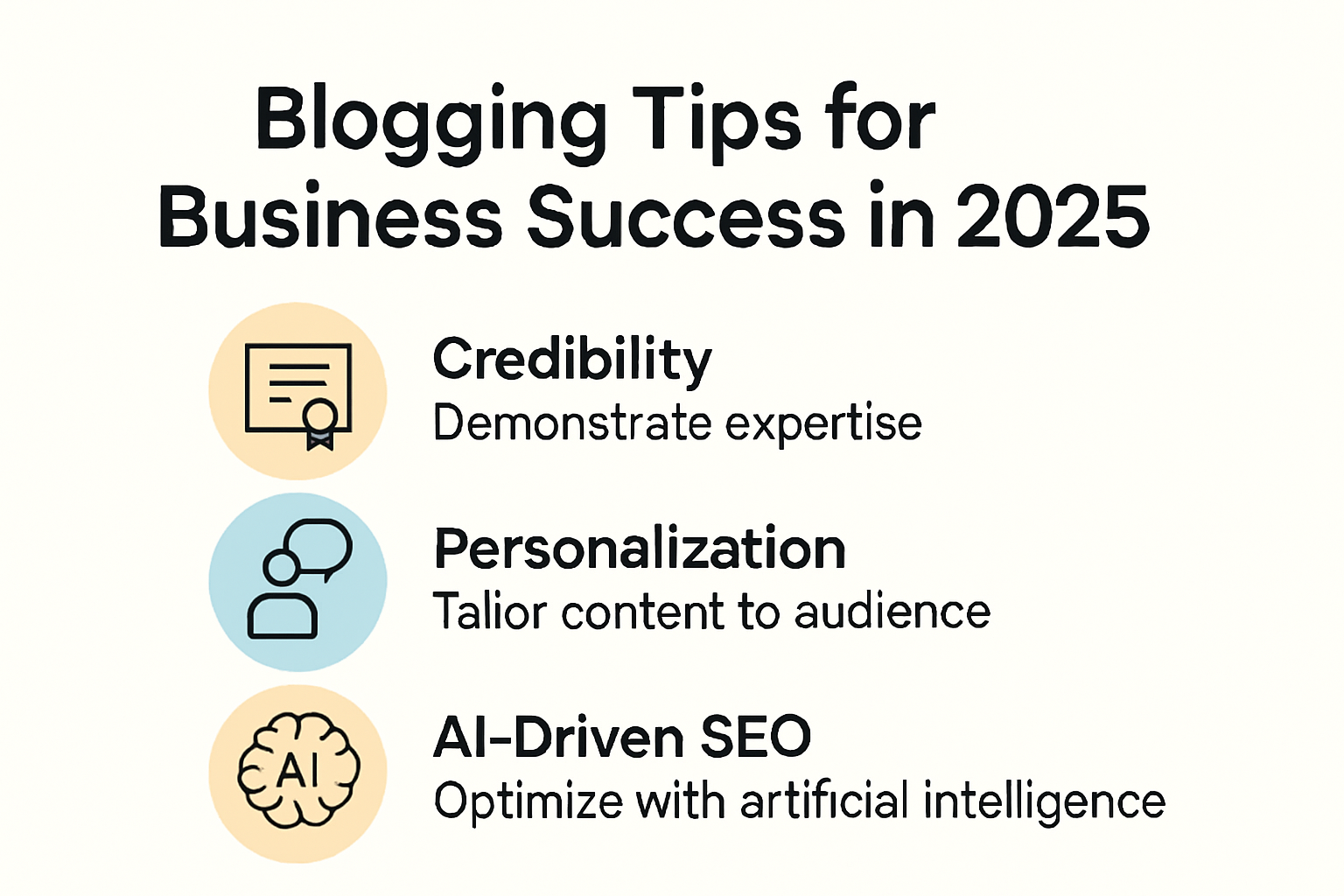Effective Blogging Tips for Success in 2025: A Guide for Businesses


Blogging is still one of the most powerful ways for businesses to connect with real people. By 2025, 43% of companies say establishing author credibility is now mission-critical for search visibility. Surprised? Most people focus on flashy headlines or social media shares, not the badges of expertise behind the words you read. Genuine trust—built with deep expertise and original research—turns casual readers into loyal customers faster than any viral trend.
Table of Contents
- Planning Your Blog Strategy For 2025
- Creating Engaging Content That Converts
- Optimizing Blog Posts For Seo Success
- Promoting And Measuring Your Blog Performance
Quick Summary
| Takeaway | Explanation |
|---|---|
| Establish credibility through expertise | Showcase author credentials and original research to build trust with readers. |
| Create engaging, personalized content | Tailor your messaging to address specific audience needs for better connection and conversion. |
| Optimize for AI-driven SEO | Use generative engine optimization strategies to enhance content visibility in modern search environments. |
| Implement multi-channel promotion strategies | Distribute your blog content across various platforms to maximize reach and engagement with target audiences. |
| Continuously refine content based on analytics | Regularly assess performance data to improve blog strategies and adapt to user feedback and trends. |

Planning Your Blog Strategy for 2025
Successful blogging in 2025 requires a strategic approach that goes beyond traditional content creation. Businesses must adapt to evolving digital landscapes, focusing on creating meaningful connections with their audience through targeted, high-quality content.
Establishing Credibility Through Expert Content
Credibility has become the cornerstone of effective blogging. According to HubSpot's 2025 State of Blogging Report, 43% of businesses now emphasize establishing author credibility to meet Google's E-E-A-T standards. This means going beyond surface-level content and demonstrating genuine expertise.
To build trust, consider these strategic approaches:
- Author Credentials: Develop comprehensive author bios that highlight professional experience and qualifications.
- Original Research: Incorporate original data and insights. The same HubSpot report indicates 36% of successful content creators prioritize original research.
- Professional Verification: Link to professional profiles and published works to substantiate your expertise.
Here's a summary table to help you quickly review the top strategies for establishing blog credibility in 2025:
| Strategy | Description | Supporting Statistic |
|---|---|---|
| Author Credentials | Highlight author experience and qualifications with bios | 43% emphasize author credibility |
| Original Research | Use unique data and insights to demonstrate expertise | 36% prioritize original research |
| Professional Verification | Link to profiles and published works to validate expertise | Referenced standards (E-E-A-T) |
Crafting a Conversational and Accessible Approach
The UK Government's content design guidance emphasizes the critical importance of a personal, conversational tone. Writing should feel like a direct conversation with your reader, breaking down complex topics into digestible insights.
Key strategies for creating accessible content include:
- Write in a clear, simple language that a broad audience can understand.
- Read your content aloud to ensure it sounds natural and conversational.
- Focus on providing practical, actionable insights rather than theoretical concepts.
Data-Driven Content Planning
Modern blog strategies require a data-driven approach. This means moving beyond intuition and leveraging analytics to understand audience preferences, search trends, and content performance. Businesses should invest in tools and processes that provide deep insights into content effectiveness.
Effective data-driven planning involves:
- Regular performance analysis of existing content
- Understanding audience search intent
- Continuously refining content based on measurable outcomes
By integrating these strategic elements, businesses can create blog content that not only ranks well in search engines but also genuinely connects with their target audience. The key is to balance technical optimization with authentic, valuable communication.
Creating Engaging Content that Converts
In the competitive digital landscape of 2025, creating content that not only attracts readers but also drives meaningful action is crucial for business success. Converting casual readers into committed customers requires a strategic approach that combines compelling storytelling, targeted messaging, and psychological understanding.
Understanding Consumer Psychology and Personalization

Personalization strategies include:
- Audience Segmentation: Develop detailed reader personas that capture specific demographics, interests, and challenges.
- Tailored Messaging: Craft content that addresses unique audience segments with precision and empathy.
- Dynamic Content: Use data and analytics to adjust content recommendations based on reader interactions.
The following table summarizes key personalization strategies and their purposes for boosting content engagement in 2025:
| Personalization Strategy | Purpose |
|---|---|
| Audience Segmentation | Define and address specific demographics and interests |
| Tailored Messaging | Craft precise messages for unique audience segments |
| Dynamic Content | Adapt content recommendations based on user interactions |
Crafting Compelling Headlines and Introductions
Readers make split-second decisions about content engagement. According to research from digital marketing experts, most individuals determine whether to continue reading within the first few seconds of encountering a headline.
To capture and maintain reader attention:
- Create headlines that promise clear value
- Use powerful, action-oriented language
- Hint at the specific problem your content will solve
- Open with a provocative statement or compelling question
- Demonstrate immediate relevance to the reader's interests
Strategic Call-to-Action Development
Digital marketing professionals emphasize the importance of clear, persuasive calls-to-action (CTAs) that guide readers toward meaningful engagement.Effective CTA strategies include:
- Position CTAs strategically throughout your content
- Use action-oriented, specific language
- Create a sense of urgency
- Make CTAs visually distinct
- Offer genuine value in exchange for reader action
Successful content in 2025 is not about volume but about creating genuine connections. By understanding your audience, crafting compelling narratives, and providing clear pathways to action, businesses can transform passive readers into active, loyal customers.
Optimizing Blog Posts for SEO Success
SEO strategies continue to evolve rapidly, demanding sophisticated approaches that go beyond traditional optimization techniques. In 2025, successful blog optimization requires a comprehensive understanding of emerging search technologies and user engagement patterns.
Generative Engine Optimization Strategies
Recent research on Generative Engine Optimization (GEO) reveals groundbreaking insights into content visibility. The study demonstrates that strategic optimization can boost content visibility by up to 40% in AI-driven search environments. This means businesses must adapt their content to meet the sophisticated algorithms of modern search platforms.
Key optimization approaches include:
- Contextual Relevance: Develop content that provides comprehensive, nuanced information
- Semantic Depth: Create multi-layered content that addresses user queries from multiple angles
- Structured Information: Use clear headings, concise paragraphs, and logical content flow
Advanced Keyword and Technical Optimization
The U.S. Department of Energy's SEO best practices provide critical guidance for technical optimization. Effective SEO now requires a multifaceted approach that goes beyond simple keyword placement.
Technical optimization strategies include:
- Precise Keyword Research: Identify long-tail keywords and user intent
- Comprehensive Metadata: Craft compelling titles, descriptions, and headers
- Strategic Linking: Develop a robust internal and external linking structure
- Performance Optimization: Ensure fast loading times and mobile responsiveness
Conversational SEO Approaches
Research from the C-SEO Bench study highlights the complexity of conversational search optimization. While many emerging methods show limited effectiveness, businesses can still improve their search performance through strategic content development.
Conversational optimization techniques involve:
- Natural Language Integration: Write content that mimics conversational patterns
- Question-Based Content: Address specific user queries directly
- Comprehensive Answer Formats: Provide detailed, authoritative responses
- User Intent Alignment: Understand and match the underlying motivation behind search queries
Successful SEO in 2025 is not about gaming the system but creating genuinely valuable content that meets user needs. By combining technical optimization with high-quality, user-focused content, businesses can achieve sustainable search visibility and audience engagement.
Promoting and Measuring Your Blog Performance
Successful blog performance extends far beyond content creation. In 2025, businesses must adopt sophisticated promotional strategies and implement robust measurement techniques to understand and enhance their digital content's impact.
Strategic Content Distribution Channels
Promoting blog content requires a multi-channel approach that maximizes visibility and engagement. Modern digital marketing demands strategic distribution across various platforms to reach diverse audience segments.
Effective promotional strategies include:
- Social Media Targeting: Utilize platform-specific features to reach precise audience demographics
- Email Newsletter Integration: Develop segmented email campaigns that highlight blog content
- Professional Network Sharing: Leverage platforms like LinkedIn for industry-specific content distribution
- Cross-Platform Syndication: Repurpose content across different media formats
Advanced Performance Analytics
Research from the National Institutes of Health emphasizes the critical importance of comprehensive web analytics in understanding blog performance. Modern businesses must move beyond basic traffic measurements and dive into nuanced engagement metrics.Key performance indicators to track:
- Traffic Sources: Understand where readers discover your content
- Engagement Rates: Measure time spent, scroll depth, and interaction levels
- Conversion Metrics: Track how blog content translates into tangible business outcomes
- Audience Demographics: Analyze reader characteristics to refine targeting
Continuous Optimization and Adaptation
Blog performance is not a static metric but a dynamic process requiring constant refinement. Successful organizations treat their content strategy as an evolving ecosystem that responds to audience feedback and technological changes.
Optimization approaches include:
- Regular Content Audits: Systematically review and update existing blog posts
- Audience Feedback Loops: Implement mechanisms to gather and incorporate reader insights
- Competitive Benchmarking: Compare performance against industry standards
- Predictive Analytics: Use advanced tools to forecast content trends
Effective blog promotion in 2025 requires a holistic approach that combines strategic distribution, sophisticated analytics, and a commitment to continuous improvement. By treating your blog as a dynamic communication platform, businesses can transform content from a passive communication tool into an active driver of engagement and growth.
Frequently Asked Questions
What are the key strategies for establishing credibility in blogging for 2025?
To establish credibility in blogging for 2025, businesses should focus on showcasing author credentials, incorporating original research, and providing professional verification through links to published works or profiles.
How important is personalization in blog content creation?
Personalization is crucial in blog content creation. Research shows that 71% of consumers expect personalized experiences, requiring businesses to tailor messaging to address specific audience needs and segmentation effectively.
What optimization techniques should I use for SEO success in 2025?
For SEO success in 2025, focus on generative engine optimization strategies, advanced keyword and technical optimization, as well as conversational SEO approaches that align with user intent and create natural language content.
How can I measure the performance of my blog effectively?
To measure blog performance effectively, track key performance indicators such as traffic sources, engagement rates, conversion metrics, and audience demographics, while continuously refining your strategy based on insights gathered from advanced analytics.
Ready to Transform Your Blog into a Growth Engine in 2025?
Most businesses struggle with building true credibility, keeping up with fast-changing SEO requirements, and consistently publishing content that both ranks and converts. The article above revealed how important it is to showcase real expertise, personalize your message, and use advanced SEO strategies such as Generative Engine Optimization. But managing this workflow on your own can feel overwhelming, especially when your competitors are scaling faster and Google’s standards keep rising.

Stop worrying about content creation gaps and SEO uncertainty. With BabyLoveGrowth.ai, you tap into a powerful platform that handles business analysis, personalized 30-day content planning, and fully automated article creation. Skip the guesswork and let our AI elevate your authority, maximize your organic traffic, and save you hours every week. Explore how automated SEO content generation can help your business outpace competitors in 2025. Visit BabyLoveGrowth.ai and start your path to blogging success now.
Smart SEO,
Faster Growth!
Most Read Articles

Generative Engine Optimization (GEO)
Learn how Generative Engine Optimization (GEO) helps your content rank in AI search engines like ChatGPT and Google AI. This comprehensive guide explains the differences between SEO and GEO, why it matters for your business, and practical steps to implement GEO strategies for better visibility in AI-generated responses.

Track LLM Traffic in Google Analytics 4 (GA4)
Learn how to track and analyze traffic from AI sources like ChatGPT, Claude, Perplexity, and Google Gemini in Google Analytics 4. This step-by-step guide shows you how to set up custom filters to monitor AI-driven traffic and make data-driven decisions for your content strategy.

How to Humanize AI Text with Instructions
Learn practical techniques to make AI-generated content sound more natural and human. This guide covers active voice, direct addressing, concise writing, and other proven strategies to transform robotic text into engaging content.

Open AI Revenue and Statistics (2024)
Comprehensive analysis of OpenAI financial performance, user engagement, and market position in 2023. Discover key statistics including $20B valuation, $1B projected revenue, and 100M+ monthly active users.